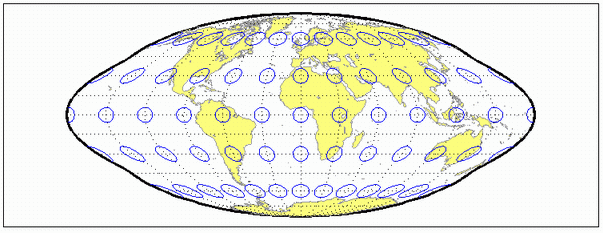goode
Goode Homolosine Projection
Classification
Pseudocylindrical
Identifier
goode
Graticule
Central Meridian: Straight line 0.44 as long as the Equator.
Other Meridians: Equally spaced sinusoidal curves between the 40º44'11.8'' parallels and elliptical arcs elsewhere, all concave toward the central meridian. The result is a slight, visible bend in the meridians at 40º44'11.8'' N and S.
Parallels: Straight parallel lines, perpendicular to the central meridian. Equally spaced between the 40º44'11.8'' parallels, with gradually decreasing spacing outside these parallels.
Poles: Points.
Symmetry: About the central meridian or the Equator.
Features
This is an equal-area projection. Scale is true along all parallels and the central meridian between 40º44'11.8'' N and S, and is constant along any parallel and between any pair of parallels equidistant from the Equator for all latitudes. Its distortion is identical to that of the Sinusoidal projection between 40º44'11.8'' N and S, and to that of the Mollweide projection elsewhere. This projection is not conformal or equidistant.
Parallels
This projection has one standard parallel, which is by definition fixed at 0º.
Remarks
This projection was developed by J. Paul Goode in 1916. It is sometimes called simply the Homolosine projection, and it is usually used in an interrupted form. It is a merging of the Sinusoidal and Mollweide projections.
Limitations
This projection is available in an uninterrupted form only.
Example
landareas = shaperead('landareas.shp','UseGeoCoords',true);
axesm ('goode', 'Frame', 'on', 'Grid', 'on');
geoshow(landareas,'FaceColor',[1 1 .5],'EdgeColor',[.6 .6 .6]);
tissot;
Version History
Introduced before R2006a